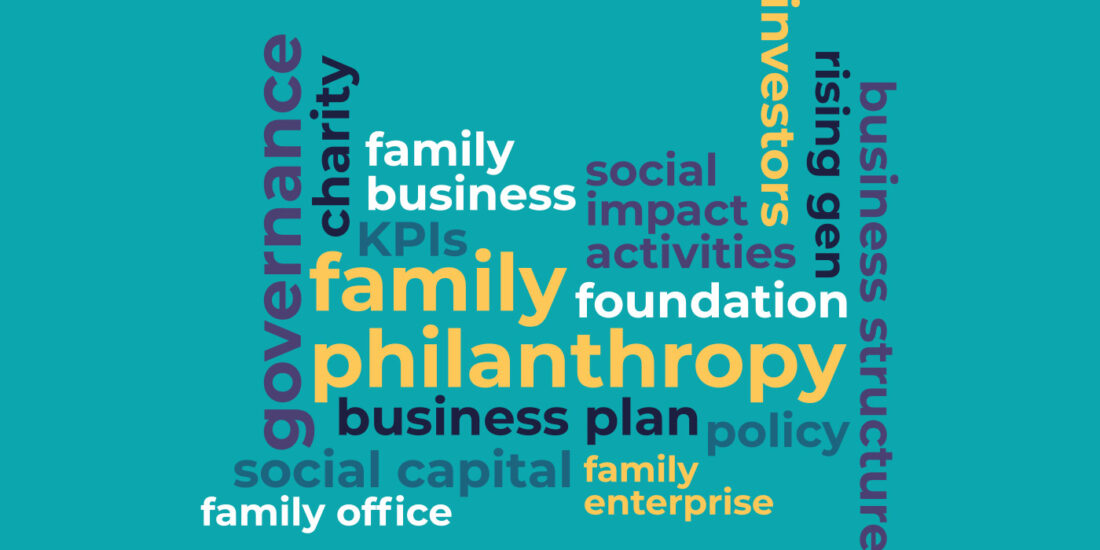Family Businesses and Community Foundations – A Natural Partnership
Community foundations are a worldwide phenomenon with more than 1400 around the globe. This week’s article presents a case study by William Lockington of LLF Lawyers LLP on how a family enterprise advisor can use a community foundation as a tool for working with clients on the topic of philanthropic legacy.
Family Businesses and Community Foundations – A Natural Partnership
William Lockington
Increasingly, family businesses are telling their stories — recounting their history, honouring their founders and enunciating the values that are the heart of their success. A natural partner for the family business legacy story is the contribution of the business and family to their community, both philanthropically and through leadership. In other words, the philanthropic legacy story.
Another, frequently overlooked partner is the community foundation. The concept of the community foundation in the US and Canada began in Cleveland, Ohio in 1914. Today there are more than 800 community foundations in the United States and 190 + in Canada, serving rural and urban communities with populations in the hundreds and millions. Combined, U.S. and Canadian community foundations hold over $40billion in assets and deliver annual grants approximating $3billion to a wide range of not-for-profit activities, including arts, culture, environmental, health, education and disaster relief.
Community foundations have many things in common with small-to medium sized family businesses. Serving geographically defined regions and municipalities, community foundations enhance life in their constituency by responding to unmet community needs through grants made in support of community projects. Governed by local boards representing broad community sectors, they build permanent capital endowment from a diverse range of public and private donors who are philanthropically inclined to serve and better their community. These foundations are the ear of the community, sensitive to its every need and aware of opportunities. As match-makers, they wed needs and projects with the capital and resources of the private sector. As facilitators, they foster collaboration between the public and private sector.
What I particularly like about the partnership of a family business and their community foundation is the other legacy value it brings to the family. Like the family business story, the family philanthropic story promotes values, offers leadership opportunities, develops consensus among family members and educates families about all sectors of their community.
The Nichols Family: an example of what I mean:
The Nichols family, in its second generation of family ownership, operated a successful recycling and salvage business. Recognizing early on that management of environmental issues would create a business opportunity; the company expanded its fleet of technologically advanced collection vehicles and invested heavily in sophisticated sort/select equipment. Acknowledged as the regional leader in reclamation, the company was extremely profitable. During its annual corporate planning retreat, expanded community support and strategic philanthropy were identified as potential enablers of business growth in the strategic review.
The family did not have what might be termed a “philanthropic advisor.” Gift giving for the family had primarily been through response to direct solicitation campaigns from established and well-known local education and health care institutions. Although significant in amounts, the cheques which were written by the business and its family members did not, in most cases, have opportunity for personal engagement with the charity. Younger members of the family were especially interested in not only giving to the organizations but participating as volunteers. Their interest in participation, as well as giving monetarily, reflects a growing characteristic of their generation to be engaged in their philanthropy. The CPA of the family business, who had participated in the strategic retreat, suggested the family speak with the executive director of the community foundation.
Invited to a family meeting, the executive director described how community foundations have become catalysts for community betterment, through entrepreneurial philanthropy that reflects vision, diversity, and inclusiveness. She explained how community foundations differentiate themselves through an enhanced level of service to donors. Professional staff analyze community needs, evaluate donor preferences and interests and then customize a philanthropy plan to meet the family needs.
Two weeks after this meeting, the executive director presented a “term sheet” outlining a plan for philanthropy to the family and its wealth advisors.
Various family members had identified a number of community interests, among them:
- the benefit of art in mental health wellness
- a new playing field for the community lacrosse team
- and naturally, the research and innovation in the field of environmental remediation being carried on at the university.
In the end, the family identified four “fields of interest” the members thought they could support.
When advised by the family of its plans to make its philanthropy strategic, the employee association of the company expressed an interest in supporting the playing field project. The family, after discussions with the executive director of the foundation, created four fields of interest funds, provided seed money to start the funds and committed to annual contributions for the future. These funds operate like small private foundations. Separately funded and accounted for under the umbrella of the community foundation, they are frequently named after founders, the family, and often are an ‘in memoriam’ fund to which a broad range of people can contribute. The Employee Association, seeing the example of the family, started its own fund, sustained by employee fundraising projects, in support of the new playing field.
The community is now enjoying the new field. The funds have grown significantly and are being added to annually. A mental health/healing art program has been formed through a partnership between the Regional Mental Health Authority and an art school, and new courses funded by scholarships are being offered in environmental sustainability at the university. Family members evaluate and select the organizations within the fields of interest who annually receive grants. Family members serve on the Boards of some of the organizations they support.
The family business legacy, so important to the well-being of their business, is now being perpetuated through a philanthropic legacy as well. Two family members, who have no children, will leave their estates to the community foundation in Founders’ Funds established by them. Two others, with dependents who will have a life interest in their estates, have left one-half of the remainder of their estates to two of the field of interest funds. The employees of the business share the philosophy of giving initiated by the family. The Nichols family now has a philanthropy advisor. The legacy of the family is being perpetuated, but with a collaborative and enduring partner, the community foundation. Business and philanthropy both create legacy. Legacy creates values which are a basis for sustainability in both business and philanthropy. The Nichols family story is an example of what this partnership can achieve.
About the Contributor
 Willliam Lockington is the senior partner of the law firm LLF Lawyers LLP. He has practiced law since 1974, primarily advising owner-managed and family businesses throughout East Central Ontario. He holds the Family Firm Institute’s Certificate in Family Business Advising and received the Certificate in Family Wealth Advising at the San Diego Conference in October. Bill leads the Estate Planning and Administration Group of the LLF Practice. He can be reached at wlockington@llf.ca.
Willliam Lockington is the senior partner of the law firm LLF Lawyers LLP. He has practiced law since 1974, primarily advising owner-managed and family businesses throughout East Central Ontario. He holds the Family Firm Institute’s Certificate in Family Business Advising and received the Certificate in Family Wealth Advising at the San Diego Conference in October. Bill leads the Estate Planning and Administration Group of the LLF Practice. He can be reached at wlockington@llf.ca.
Proposals for educational sessions are now being accepted on the conference theme Family Enterprise: Complexities, Constituencies and Constellations. Deadline to submit a proposal is January 20, 2104. Please go here to read the Call for Proposals and to submit online.
Stay tuned next week for another issue of The Practitioner.
Yours in Practice,
The Practitioner





